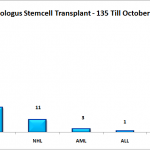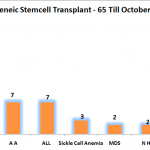Stem cell transplant is an exciting area of medicine, and currently a topic of hot debate at several fronts. It holds a great promise to ease or cure many ailments. Research is ongoing in several areas. This is an established treatment, however, for many years in the field of blood disorders (Hematology), such as leukemia, lymphoma, myeloma, thalassemia, aplastic anemia and others. Stem cell or the “Basic Cell” is a simple concept, based on the fact that all humans are made from a single cell. This cell gives rise to all body tissues and organs. Precise controls for the same are largely unknown. However, it has been found that even in adult body, there are cells which can differentiate into any type of cell, and hence potentially can recreate any tissue. This is the premise of stem cell research. If we can find these cells and understand their controls, we can recreate and replace injured or lost tissue e.g. heart attack, stroke/paralysis, diabetes, arthritis, liver or kidney damage… However, it is not easy as it sounds e.g. when we inject stem cells into an area of heart, whether they will grow into heart muscle cells or nerve cells or blood vessel wall cells and in what proportion, is currently not controllable. All of the above mentioned areas are under active research, but none except hematology is confirmed beyond doubt and therefore still remain experimental. Only established role is in Hematology where it is in use for decades. We will talk only about the established area. In spite of so much need based on existing recommendations and patient numbers, there are very few centers in India, performing regular transplants for blood disorders. According to one estimate, there are only about 300 transplants per year in India. Last year, we have done 10 transplants. For comparison, we can see European data, where every year about 30,000 transplants are performed. Our need i.e. in India is at least 50,000 transplants per year, likely much more. Cost of transplant in India is one tenth that of the cost in Western countries. However, because there are few good centers of excellence in this field, many people still go out of country for this life saving treatment. Few case examples will help to understand the impact of this method of treatment: 1. A six year old child has undergone 8 months of chemotherapy for Hodgkin’s disease. Mother reports that his lymph glands in neck never went away completely. They started increasing in size in next couple of months, and they came to us. This is primary refractory Hodgkin’s disease, and with any further traditional chemotherapy, chance of cure is nearly zero. This patient underwent high dose chemotherapy followed by autologus hematopoietic stem cell transplant, and is now in remission i.e. no sign of disease anywhere with whole body CT scans, even after more than one year. He has about 50-60% chance of being cured. 2. A 29 year old man, only son, who has a young daughter and wife is pregnant, comes with a white cell count of 180,000 (normal count should be within 4000 to 10,000). He is diagnosed to have acute myeloid leukemia, a type of blood cancer. He is put in remission with standard therapy. Risk of recurrence is high and they want to do the best possible to increase chance of cure as much as possible, with reasonably safe and proven method. He underwent high dose chemotherapy followed by autologus hematopoietic stem cell transplant. He has about 50% chance of being cured. 3. An 8 month old child is diagnosed to have Thalassemia Major. Child is undergoing regular, monthly blood transfusions, and is doing well. She is a very sweet, bright child. Over next year or so, there is increasing frustration in this educated family that this treatment is not curative and that she will survive only till age of about 20 to 30 years. They search for a better treatment, and undergo matched allogeneic stem cell transplant from her older brother. She is now transfusion free and will have a nearly normal life. Stem cell transplant in Hematology is an established therapy. Beauty of this procedure is that there is no surgery/operation involved in this whole process, unlike kidney or liver transplant. Patient is kept in his room through out the hospitalization and is otherwise reasonably well i.e. talking, eating, taking walks every day. Patient has to stay in the special unit, prepared to reduce infections. The procedure serves mainly 3 purposes: 1. Allows use of very high doses of chemotherapy, which ablate bone marrow. Without stem cell support, marrow will recover after a very long time, resulting in high death rate from infection or bleeding. Infused stem cells provide early recovery of blood cells, cutting down the risks of myelosuppression. Thus it is a form of “Supportive Therapy” and not a treatment of cancer by itself. This is the case in autologus (self) transplants. 2. Some “graft versus disease activity”, in allogeneic transplants done for hematological malignancy, especially evident in chronic myeloid leukemia. 3. Replacing a missing gene e.g. in thalassemia, sickle cell disease, and various other genetic disorders. These are diseases where a person is otherwise normal, except for one missing gene, and replacing that gene is curative.200 Transplants Completed up to October 2018
ABC of Stem Cell Transplant – Role in Blood Disorders
Hematopoietic Stem Cells
They live in the bone marrow i.e. cavity inside the bone. These cells constitute less than 1 in 100,000 in bone marrow cells. They look like small lymphocytes and cannot be distinguished from other normal cells by morphology. They are identified by special techniques such as immunophenotyping using flow cytometry, which uses different markers, most notably CD 34 in this case. These cells are capable of self renewal as well as production of progenitor cells which differentiate into mature blood cells.
How are they collected
Since during normal state they are very few in numbers, bone marrow is stimulated with use of growth factors with or without help of chemotherapy. This leads to increase in their number. Then they can be collected from either bone marrow or peripheral blood. Their number in blood can be counted daily and collection is done at right time.
Collection is done using a procedure called Apheresis, almost similar to dialysis done for patients with kidney failure. Patient or the donor is on a special chair or bed for about 6-8 hours per day, for 1-4 days. During the apheresis procedure, he/she can talk, eat, watch TV, read normally. Procedure is nearly risk free. Also, there is no permanent loss from body i.e. unlike kidney or liver transplant, donor is not losing anything permanently. Stem cells are recovered by body in few days time. Because of such safety of this procedure, and because this is such a life saving treatment, over 15 lakh people have registered themselves as voluntary donors in USA alone, in a national registry. Unfortunately, there is no registry in India.
Storage: Total number is then counted and storage is done after adding special chemicals and at very low temperatures (at minus 80 degree celcius or in liquid nitrogen) to maintain their viability for a long time.
When needed, the bag full of stem cells and additive liquids is thawed and transfused with some specific precautions (almost like a blood transfusion). So, once again, there is no operation involved in this type of transplant.
Sources of Hematopoietic Stem Cells
Sources of Hematopoietic Stem Cells:
1. Bone Marrow
2. Peripheral Blood
3. Cord Blood
When stem cells are collected from one’s own body, it is Autologus Transplant.
When stem cells are collected from someone else’s body, it is Allogeneic Transplant.
Cord blood stem cells have certain specific advantages and disadvantages. Cord blood registries are now available for use in certain conditions, and more registries are up coming.
Indications
Autologus: mainly different types of blood or lymph gland cancers
1. Non Hodgkin’s Lymphoma – For recurrent/resistant cases, it is standard therapy and in most such cases, it is the only curative option.
In some high risk cases, where chance of recurrence is very high based on known prognostic criteria, it can be done upfront.
2. Hodgkin’s Lymphoma – For recurrent/resistant cases, it is standard therapy, and in most such cases, it is the only curative option.
3. Myeloma – Although not curative, it is standard treatment as part of initial therapy, as it prolongs survival substantially. It is perhaps the commonest indication for transplant in western countries.
4. Leukemia – Increasingly being used for Acute Myeloid Leukemia as part of initial therapy, to increase chance of cure in this dreadful disease.
Allogeneic: several indications
1. Thalassemia Major
2. Several other genetic disorders, especially with single gene defects
3. Aplastic Anemia
4. Chronic Myeloid Leukemia
5. High risk AML (acute myeloid leukemia), relapsed AML
6. Relapsed ALL (acute lymphocytic leukemia)
7. As last resort in several advanced or refractory hematological malignancies, where small but significant percentage get cured or have long term survival e.g. follicular lymphoma, CLL, myeloma…
Contraindications:
None is absolute, all are relative, since in many cases risk of underlying disease is much higher than risk of performing transplant.
1. Age: not over 60-70 in most cases, however this is changing with better conditioning regimens and supportive care.
2. Poor visceral organ function e.g. significant disease of heart, lung etc
3. Lack of a good matched donor – once again, this is slowly changing as well, with increasingly mismatched transplants now being feasible.
Risks:
These transplants are done with high doses of chemotherapy and other highly immunosuppressive agents entailing risks of the same, as well as risks of graft versus host disease. Most common risks are related to infection, bleeding, chemotherapy related organ injury e.g. kidney/liver/lungs, graft versus host disease.
Mortality of transplant has reduced significantly, and is now in the range of 5-10% for Autologus Transplant and about 10-30% for Allogeneic Transplant, depending upon indications and host factors.
Cost:
Mainly related to use of blood products, antibiotics/antifungals etc, isolation unit, specially trained staff, chemotherapy/immunosuppressive agents, investigations, stem cell collection and storage. About 5 lac for Autologus and about 10 lac for Allogeneic.
Indian Perspective:
We see comparatively younger patients, almost by a decade, with respect to western data. These are the patients who can tolerate aggressive treatments like transplant better. Newer medicines are often very expensive and add a smaller increment to survival e.g. for non hodgkin’s lymphoma, Rituximab is a good drug. At a cost of about 6 lac for the course, it adds about 15% increase in absolute survival when used upfront with chemotherapy. It does not cure relapsed lymphoma. However, at a cost of 5 lac, autologus transplant can cure much higher number of relapsed lymphomas. It should be investigated for upfront therapy of high risk lymphomas in India. Such study is unlikely to come from Western countries, since they can afford more expensive medicines today, and will not take such a risk. Same is true for many other diseases mentioned above.
Thalassemia major has a very good cure rate with transplant, and we have a very high number in India, especially in Gujarat.
Research in stem cell technology is likely to further improve safety profile of these therapies, and also reduce cost.



